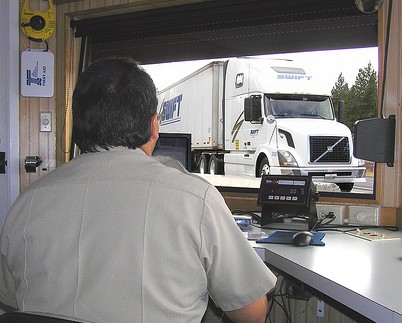Posts tagged ‘road’
What are Truck Weigh Stations for?
There are truck weigh stations scattered along most major highways in the US, Canada, Taiwan and other countries. Obviously they’re there to weigh trucks, but why do trucks need to be constantly weighed?
Vehicles that weigh more than 26,000 pounds or have 3 or more axles have to pay fuel taxes. Motor homes and other private (non-commercial) vehicles are generally exempt. For example, if you see a race-car team drive by, you’ll often see “not for hire” on the side of the cab. That suggests the vehicle is exempt from the fuel tax charges and keeps other trucking companies from soliciting their services.
Truck weigh stations were originally developed for states to collect the fuel taxes they were owed by the commercial trucks using their roadways. It is similar to the licensing concept that I talked about in a previous post, Why U-Hauls Have Arizona License Plates.

In North America, weight stations aren’t directly used for that purpose anymore. There is now an International Fuel Tax Agreement which allows truckers to file a quarterly tax report. Weigh stations are still used to enforce the tracking and submission of the logs and the payment of the fuel tax.
The scales are still used to enforce weight restrictions. The federal weight restriction is 80,000 pounds. Trucks need a trip permit to transport a load exceeding that weight.
Some weigh stations are pretty high-tech, supporting “weigh-in-motion” technology. This technology can allow truckers to bypass weigh stations entirely. This involves the truck driving over a scale that is built into the right lane of the road, usually about a mile before the weigh station. Depending on the weight of the vehicle, its history and the history of the trucking company, the weigh station operator or an automated system will decide if the truck needs to pull into the weigh station.
Truckers who use these systems have a transponder in their truck, similar to those used for electronic toll collection. If they can skip the weigh station, they will usually get a green light on the transponder. If they need to pull in, they will get a red light.
Weigh stations are also used for safety inspections of vehicles. Truckers often refer to weigh stations as “chicken coops.” Check out my post on trucker signals for more trucker slang.
Broken Secrets | By: Chad Upton
Subscribe on: Facebook | Twitter | Kindle
Sources: Wikipedia (weigh station, IFTA, weigh in motion)
Photo: OregonDOT (cc)
Rear Fog Lights
Most North American cars have one set of bright lights on the back, of course those are the brake lights. But some American cars and most European cars have other bright lights on the rear: rear fog lights.
If you’re not familiar with this concept, then you probably assumed their lights were malfunctioning or their break lights were “stuck.”
Rear fog lights make it much easier for the vehicle behind you to see your car when fog, rain or snow is heavy.
Some rear fog lights are a pair of lights mounted low on the rear bumper. Other cars have a single light, mounted near the driver’s side rear turn signal.
There are debates about the validity of rear fog lights. Some claim they can be confused with brake lights, others agree but believe that is still safer than not seeing the vehicle until it is too late.

In the photo of the instrument cluster, the icon on the left is the front fog light indicator and on the right is the rear fog light indicator.
Some cars have separate switches for front and rear fogs, other cars have one switch that activates both.
Studies have shown that in North America more people inappropriately use their fog lamps in dry weather than use them properly in poor weather
BrokenSecrets.com
Photo Credit: mroach (Creative Commons)
Sources: DriveAndStayAlive.com Wikipedia SAE
 shows that 19 of the 40 participants have eaten roadkill and another 9 wouldn’t hesitate when the buck drops. I’m sure that number would be much lower on any other website, but that’s not the point. I just heard about this last week, and there is a logical reason for this: there may be $500 worth of meat on a dead deer, and that doesn’t change whether you took it down with a
shows that 19 of the 40 participants have eaten roadkill and another 9 wouldn’t hesitate when the buck drops. I’m sure that number would be much lower on any other website, but that’s not the point. I just heard about this last week, and there is a logical reason for this: there may be $500 worth of meat on a dead deer, and that doesn’t change whether you took it down with a 



